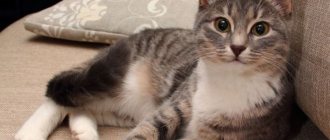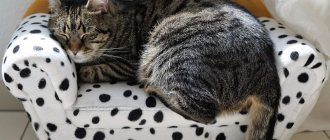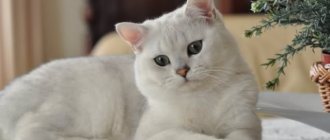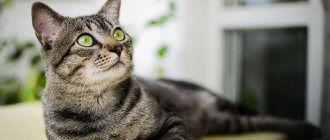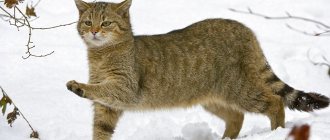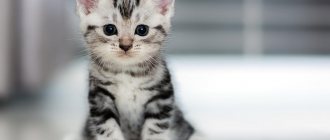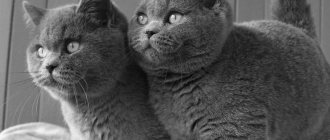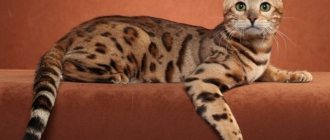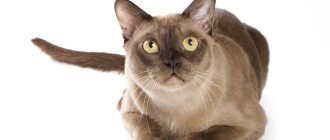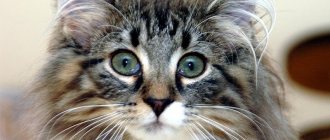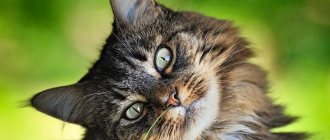Keeping a Celtic cat
Animals adapt to any, even Spartan, conditions. EKSH are neat, clean and do not tend to tear up walls/sofas. Toys with moving mechanisms will help satisfy hunting inclinations.
Care and hygiene
Thanks to their outdoor background, these cats require less care than others. Nature has endowed them with short hair so that dirt and parasites do not linger in it, and most EKSH cannot tolerate bath procedures. Only show-class animals that will show off at exhibitions are bathed.
The rest of the cats lick themselves, allowing the owners only to periodically comb out the hair that falls out (especially when molting). Innate cleanliness contributes to rapid adaptation to the tray, whose contents must be removed immediately. Those cats who go outside have even fewer problems with the toilet, but their ears need to be examined more often, where ear mites appear. If necessary, wipe the ears and eyes with a damp cotton swab and saline solution.
Celtic cat diet
The European Shorthair has no special food requirements. Kittens up to 3 months are fed (with an emphasis on dairy products) 6 times a day, after 4 months they are transferred to 2 meals a day. The Celtic cat can easily adapt to commercial food (dry and wet) labeled “super-premium” or “holistic”.
Pelleted food goes well with a natural diet. For the latter we recommend:
- meat (raw and cooked);
- sea fish (fresh and boiled);
- vegetables (in various forms, except fried);
- eggs;
- fermented milk products;
- porridge.
The menu should not be dominated by carbohydrates: a cat, like any predator, needs animal proteins. In addition, raw/solid foods will benefit from helping to clear away plaque.
Diseases and breed defects
Perhaps this is one of the rare cat breeds whose body does not suffer from hereditary diseases. The immunity of the Celtic cat has been forged over centuries and has not been spoiled by the noble blood of other, often pampered breeds. The only source of danger for EKSH are considered to be infections that even a cat sitting in an apartment can pick up: bacteria/viruses enter the house along with clothes and shoes.
The first vaccinations for kittens are given at 8 weeks (if the cat was not vaccinated before birth) or at 12 weeks (with prenatal vaccination). 10 days before immunization, kittens are dewormed.
Feeding cats
Starting from the age of three weeks, kittens need clean water, which is placed at several points around the room so that the kids do not forget to drink. The best option is to get a fountain that will always provide clean, oxygenated drink.
Table 2. Approximate diet for kittens.
Age of the kittenProductsDaily feeding frequency
| From 1 month |
| 5–6 times |
| From 2 months |
| 5–6 times, increasing portions |
| From 3 months | Finally transferred to food for adult cats | up to 4 times |
After the second month of life, kittens can be switched to professional food - dry and wet.
The following are prohibited at any age:
- animal fats, especially rendered;
- pork;
- fried, fatty, smoked;
- sweet and salty;
- dishes from the host's table.
Delicacies from the master's table are prohibited
The cat remains playful and in a good mood only if it receives enough quality food. The diet of adult cats must include the following products:
- lean poultry, beef, veal, freed from bones and sinews;
- cereals (rice, buckwheat) - up to 20%;
- chicken liver, beef heart (once a week);
- stewed vegetables (zucchini, cauliflower and white cabbage), greens (spinach, lettuce);
- sea fish - preferably cod, haddock (no more than once every 7 days);
- cottage cheese with a fat content of up to 9%, three-day kefir (fresh causes digestive disorders).
The meat is boiled, cut into fingernail-sized cubes, and mixed with grains and vegetables. Olive oil and a little bran are also added there. It is believed that the best product for cats is chicken. But this is not true, it does not contain enough amino acids and nutrients. Therefore, you should not feed cats exclusively this type of meat. It is better not to offer milk to cats: it can cause loose stools. Not every cat's body has the enzymes necessary to digest this product.
It is better not to include milk in the diet
The wool will tell you whether the diet is correct. If it is shiny and soft, then there are enough nutrients. If you have problems with the skin, you should contact your veterinarian. He will determine the cause and, in case of vitamin deficiency, prescribe appropriate medications. In any case, with a natural feeding method, it is necessary to constantly or periodically add vitamin supplements to the food.
Vitamin and mineral complex Radostin
However, experienced cat breeders increasingly prefer ready-made dry and canned food. Products in the super premium class category are produced under the trademarks ProNature Holistic, Royal Canin, Sanabelle.
Experienced breeders often prefer ready-made food
New products are presented in the holistic segment. These products are chosen by professional nurseries. Unique technologies for processing meat and vegetables suitable for human consumption are used. These include Orijen, Wellness and Natural{amp}amp;Delicious.
However, the economy class segment also offers decent products, which are also characterized by a balanced set of nutrients, vitamins and minerals. These are Josera, Belcando, Advance. They can often offer treatment lines for cats with special body needs.
When feeding these animals, the owner will also not have any problems, since they are unpretentious and undemanding in choosing food. Pets will happily eat both dry food and natural food.
We suggest you read: Is the cat breathing heavily? Is this condition dangerous for the animal’s life?
If the owner prefers natural food, then he should remember that Europeans are carnivores by nature, so their menu must include meat and offal. You can diversify their diet with various cereals, vegetables and dairy products.
Archaeologists consider the Celts to be a mysterious people. Their food preferences are puzzling. The Celts who lived in Ireland did not cook dishes from crane, the British Celts refused to eat chicken and hare, but our Celtic cat is of European origin, which means she does not have any strange food taboos.
You can feed your European cat both natural food and prepared food. The main thing is not to be greedy in portion sizes and remember that the menu should contain at least 30% pure meat (not offal)!
Milk, raw fish and confectionery are foods that should not be given to cats in principle!
Archaeological scientists believe that the Celts were a rather mysterious people. And their eating habits cannot but surprise them. For example, the Irish Celts never ate crane meat, and the Celts from Britain did not eat chicken or hare meat. However, Celtic cats are still European by blood, so they do not have any dietary restrictions.
The animal can be fed with both ready-made store-bought food and natural food. The most important thing is not to limit portion sizes and not to forget that meat in the diet of a European Shorthair should be at least 30%. Moreover, we are talking about pure meat, and not offal: the cat will not consider them meat.
Features of behavior
Of course, each cat is different from others to one degree or another and has its own character. But representatives of the same breed still have common features. As a rule, European Shorthairs are smart, very affectionate and quiet cats. They quickly adapt to new conditions and are unpretentious. They almost immediately become attached to their owner and love him very much and are devoted to him.
But it happens that among quiet people there are energetic restless ones who love to play and be naughty. They are quite unpredictable. People who value the natural instincts of cats will find them comfortable and not boring.
They are quite delicate and are not intrusive. Only something serious can make them angry - like a real threat to life. Very, very inquisitive.
They do not consider a person to be a master; for them, he is rather a neighbor, a partner. They do not demonstrate their feelings, they are extremely restrained.
Character
- Due to their long wild history, Celtic Shorthairs are among those that roam on their own. When placed in a new environment for some time, representatives of this breed devote all their time to studying the environment and getting to know family members. Don’t be surprised if in the first few days she won’t let you approach her and won’t go into the arms of any of the household members.
- When the Celtic cat gets used to it, it will begin to take an active part in all household chores with great enthusiasm. Not a single corner in your home will be left without her attention.
- At the same time, representatives of this breed are extremely unobtrusive and do not require constant attention. If there is no one at home, they will find something to do. If they have toys at their disposal that can be pushed around the floor, the Celtic cat, in order not to lose its hunting instincts, will play with them with great pleasure.
- The Celts are wary of guests, as they see any stranger as a potential threat. At the same time, they will not show aggression or hatch an insidious plan to expel a stranger from home. They will simply quietly retreat to their favorite secluded place and watch what is happening.
- They prefer not to conflict with other animals, especially if they are larger in size, but their attitude cannot be called friendly either.
- Therefore, for everyone’s peace of mind, it is better for the Celtic Shorthair to be the only pet in the house.
Recommended reading:
Burmilla: description of the breed, proper care, photos of cats
Personality of European Shorthair cats
This breed is ideal for those looking for an affectionate and intelligent four-legged friend. When an animal finds itself in a new place for the first time, it may begin to hide. This is a natural reaction to stress from a change of environment, but it passes quickly, and in a short period the cat fully adapts to the new home.
Independence is not the main feature of this cat, but it still occurs in a few representatives. They are mostly playful and cheerful creatures. You can easily go to work, leaving your cat alone at home; it does not require much attention. Pets do an excellent job of entertaining themselves on their own and do not suffer from loneliness at all.
An amazing feature of the breed can be considered the ability to blush - this is how cats get nervous. The nose and toes become red. Along with this, they also sweat
It is very important that European Shorthairs under no circumstances rush at people or scratch themselves. They only hiss, but never bite, so for small children such an animal will be an ideal companion.
Contact and friendliness are what distinguish shorthaired Europeans. If you don't want to interact with this cat, she will never bother you. This animal delights with its easy character and tact.
Character and behavioral characteristics of the Celtic cat
The second name of the Celtic breed is European Shorthair. For many centuries, cats have lived next to humans in both city apartments and village farmsteads. The history of the formation of the breed laid the foundation for strong immunity to infections and excellent health for its representatives.
At first glance, the usual simplicity of appearance does not make an impression. Cats just seem ordinary and nondescript. When communicating with animals, their captivating naturalness and straightforwardness are revealed - this is precisely the value of the breed. It is no coincidence that recently Celtic shorthair cats have been actively represented at many exhibitions.
The movement, gait, and manners reveal the amazing grace of the animal, which no photograph can convey. The silent steps of first the left and then the right legs in a characteristic alternation attract attention.
The feigned imposingness of cats does not reflect the affection and manifestations of feelings of these affectionate and faithful pussies. Among people they behave as equals. Some people consider cats to be proud, even arrogant.
The secret is that the animal behaves selectively towards the people around it. The Celts choose themselves with whom they want to communicate and show tender feelings. They do not allow themselves to be treated with disdain. The choice of a beloved owner determines the pet’s lifestyle: it will follow on its heels, adopt habits, and wait for attention.
Vivid hunting instincts are the main feature of the breed, for which breeders value them so much. This determines their active, playful character. The objects of hunting can be shadows on the wall, insects, sunbeams, flies.
The passion for hunting manifests itself at night, when rustles and sounds attract curious animals. The cheerful disposition reflects the independence of cats, which quickly adapt to a new environment and become attached to owners who take care of them.
Each individual European Shorthair cat is individual in its manifestations. Many people know the unpretentiousness and gentleness of the Celts. They are responsive to any manifestation of care for them, natural and beautiful with their natural appearance. They are not obsessive, but their gifted curiosity drives them.
An important aspect of cats is their independent behavior. They will not go hungry with forgetful owners; they will find food themselves, even from the refrigerator. They do not recognize other four-legged animals on their territory. They will be able to ruin their lives masterfully, without even showing aggression.
The European Celtic cat has a high level of intelligence compared to other breeds. She will cope with the task if others do not dare to overcome difficulties.
Cats do not require special attention. But caring for your beloved pet should include bathing at least once every six months. Cats have strong nerves and tolerate the procedure without complications. It is recommended to brush the coat regularly.
Cats are inherently neat and clean. They rarely get sick. But vaccinations should be protection against possible infections. They are necessary for all animals, including pets that do not leave apartments.
Before vaccinations, cats are freed from parasites. Periodic cleaning of ears, teeth, eyes, and examination by a veterinarian will strengthen the immunity of the Celtic breed of cats.
Unusual behavior indicates a pet's illness: refusal to eat, lack of activity, photophobia. In this case, a visit to the veterinarian is mandatory. The diet of pets can consist of purchased ready-made food and natural food.
It is important to monitor the quality of food, which should include up to 30% meat, exclude milk, fresh fish, and sweet additives. Food made from offal is not complete; cats reject such food.
The character of European Shorthairs can be called complex. Representatives of the breed are distinguished by pride and even some arrogance. Such a cat will communicate only with those who recognize her as an equal: these willful animals will not tolerate any humiliation.
Owners of European Shorthairs note the independence and love of freedom, as well as the unobtrusiveness of their pets. It’s worth mentioning separately about independence: even if you forget to give your cat food, she will be able to get it from the refrigerator on her own.
The hunting instincts of European shorthair cats have not disappeared even after many years of living together with people. Therefore, the cat will hunt in any case: if not for mice, then for flies or even random shadows on the walls. Moreover, this hunt will take place mainly in the dark.
European shorthair cats do not like to “talk”: silent cats will only speak up in extreme circumstances, for example, if someone carelessly steps on their beautiful tail.
The cat will treat the four-legged human friends living in the same territory with it quite aggressively. Therefore, it is advisable to keep a European shorthair cat alone; the animal may not tolerate being around, and she will be able to create trouble for her fellow cats expertly.
European Shorthairs are interesting for their adaptive abilities. Having chosen one leader among the household members, they will begin to imitate his manners and habits. Therefore, if your pet chooses you, don’t be surprised if she gets up and goes to bed at the same time as you and even starts watching her favorite TV shows with you.
European shorthair cats are a native breed. They are not weakened by changes in habitat and forced crossing, and therefore are distinguished by their endurance and good health.
"Celts" are ideal for the role of pets. They are smart, positive, independent, energetic. They can be left alone at home without fear; these cats do not require constant attention and can find something to do on their own, but at the same time they will not cause mischief, turn wallpaper into shreds or knock over valuable porcelain.
We suggest you read: Is a cold in a kitten dangerous? How to treat a kitten for a cold How to treat a cold in a 2 month old kitten
The European Shorthair is easy to train, can learn commands, but will only carry them out according to its mood. The character of representatives of this breed is self-sufficient and independent; they do not tolerate rudeness and familiarity, but behave tactfully. “Celts” know how to get along with children and are not afraid of guests, but they do not get along well with other pets.
A private house is best suited for them to live. They love to spend time outdoors, having fun hunting.
The European Shorthair cat has a “comfortable” character. She is accommodating and loyal, and her habits and habits are shaped by the owner himself. In fact, the Celts are considered kind and peaceful, but it all depends on how a person will raise her. This cat will reciprocate anger and aggression, but at the same time will lose self-esteem and intelligence.
They say about Celtic cats that their eyes are the mirror of the owner’s soul. Over the years, the cat adopts the habits of its owner, sometimes copying it. I recently noticed the same qualities in my cat. She is not purebred, but it seems to me that there were Celts in her family. I often notice that she prefers the same food as me (she, for example, does not ask for sausages when there are cucumbers on the table).
Celtic cats have a truly “feline” character - they are free, playful and affectionate.
Despite her gift for adaptation, the European Shorthair will not tolerate another cat in her home. As the leader of the home, this cat agrees to recognize only a person, well, or herself. To avoid conflicts, it is advisable that only one cat live in a house/apartment. The same can apply to other animals.
When guests come to the owners of the European Shorthair cat, the animal shows its indifference. The Celt will not ask to be held in his arms to be caressed, but if he needs something, he will still get it. The Celt tries to communicate with children as equals. This cat will ignore arrogance and aggression if it considers a child to be its friend. Many cat owners consider Celts to be intelligent cats, capable of understanding human language.
The Celtic cat is the “golden mean” (it is unobtrusive, but affectionate, a leader, but not an aggressor)
European shorthair cats do not require any special care. However, simple rules for caring for a cat must be followed. Any cat needs proper nutrition, a comfortable place to sleep and hygiene measures.
The Celtic cat can be fed natural food and commercial food. The main thing is that cat food must be properly balanced. Foods such as Go!, Leonardo, Applaws, etc. are suitable for daily diets for the Celt. In addition, you can choose a not very expensive food suitable for British shorthair cats (for example, Royal Canin has such a product).
As natural food for the Celt, you can use almost any product allowed for cats. The diet should contain proteins, fats and carbohydrates, food should be fortified and fresh. Typically, meat (including offal), ocean fish (for example, once a week), vegetables, cereals, dairy products, etc. are used to prepare food for cats.
| Advantages | Flaws |
| Relatively low cost of a kitten. | Simple appearance, very close to the appearance of non-pedigreed cats. |
| Undemanding in care, nutrition and maintenance. | Low popularity of the breed in Russia. |
| High level of health. | Lack of nurseries in the country. |
| Friendly character, good attitude towards children and other family members, ability to be alone. | |
| Quickly masters the litter tray and other rules of behavior in the house, cleanliness. | |
| Has the instincts of a good hunter and can protect the house from rodents. |
Description
The European cat has a strong build and can be large in size. However, even with such dimensions, the animal cannot be called clumsy. The pet is characterized by flexibility and dexterity in movement. These short-haired cats have a slightly fluffy tail. It is wide at the base and tapers towards the tip, acquiring a rounded shape. Externally, the Celtic cat breed has a number of individual characteristics.
- The head is slightly oblong and cone-shaped. The cheeks stand out noticeably.
- The pet's ears are medium in size, set high, and rounded at the tips. Some representatives have rather unusual tassels, which do not spoil at all, but, on the contrary, add originality to the appearance of the cat.
- Expressive large eyes have a round shape. Their color always goes well with the coat color.
- The Celt's chest is very massive and wide, the neck is muscular and of medium length.
- Powerful paws are very well developed and fit perfectly into the proportions of the animal’s body. The wide limbs gradually taper downwards. The paws have a rounded shape.
- The short, shiny fur of the European cat is very soft and dense to the touch, and has a natural density.
- The weight of representatives of this variety varies from 4 to 8 kilograms. It is worth considering that males are much larger than European females.
The European cat is famous for its variety of coat colors. Each country has its own color preferences. This is due to the fact that breeders carried out large-scale work on breeding such pets, and specialists representing many countries took part in this process. By the way, the Germans give their preference to cats whose coat color has light or silver shades.
In domestic markets, celts with the following colors are very often found:
marble;
If you do not plan to participate with your pet in cat shows, then color, in general, does not matter at all. When choosing a cat, everyone can start from their preferences.
Cats of the following colors are not allowed for exhibitions:
- chocolate;
- lilac;
- faun.
It is also worth mentioning some external disadvantages of this breed:
- possibility of hybridization - Celts are very similar to other breeds of their species;
- excessive sagging of the animal’s cheeks;
- rough transition from the frontal part to the muzzle.
Representatives of the Celtic cat breed live an average of 16 years. This indicator can be increased by creating comfortable conditions for keeping the pet.
Description of appearance
- Color: all types except lilac, color point, chocolate, fawn and cinnamon.
- Eyes: round, set wide and slightly at an angle, color matches the coat.
- Ears: Set wide apart, slightly rounded, possibly tufted.
- Tail: Medium length, wide at the base, tapering to the tip.
- Coat: thick, dense, short, shiny, hard, close to the body.
We invite you to read: Malassezia fungus in cats, main manifestations and methods of treatment
https://www.youtube.com/watch?v=9QLkET2tXVM
It is difficult for an inexperienced person to distinguish Europeans from other breeds of domestic cats. Even in the photo, the European Shorthair cat is surprisingly similar to the British Shorthair cat and only specialists can distinguish them.
- These are quite large animals with a proportional, powerful build. The cat's body is strong and muscular, with a wide, rounded chest and a straight, strong back.
- Adult representatives of this breed can weigh from three to seven kilograms. Like most cat breeds, females are inferior to males in height and weight, and weigh no more than four to five kilograms.
- The legs are short, but powerful and muscular. The paw pads are wide and rounded. The hind legs are slightly longer than the front legs.
- Europeans have a thick, medium-length tail, slightly tapering to a rounded tip.
- The head is wide, but unlike the same British, it is not round, but triangular in shape, with clearly defined cheekbones and a straight nose.
- Cats' ears are medium-sized and straight, with rounded tips and small tassels.
- Large, round, widely set eyes give the animals a wary and slightly gloomy appearance. Eye color depends on the color of the cat. In individuals with red or brown fur, the eyes have an amber or yellow tint. Representatives with black or snow-white color have emerald green eyes. Cats with smoky gray or silver coat colors may have eyes that are olive green or grayish blue.
- Europeans have a short, dense and thick coat. One of the features of the coat of these cats is that it is surprisingly silky, shiny and iridescent.
- Almost any color of the European Shorthair cat is recognized as the breed standard. The color palette of these creatures is very diverse. Among them there are both representatives with a uniform fur color, and animals with stripes and spots of various shapes, different in color from the main coat color. Only cats of this breed with a lilac, chocolate or acromelanic color are not allowed to participate in competitions.
Health and care
The Celts inherited good immunity from their ancestors, so they hardly get sick, and they are also very hardy. These cats are not afraid to swim, as their nerves are in perfect order. However, European shorthairs are very clean themselves.
Keeping the fur in order is quite simple: care consists of brushing the cat twice a week at regular times, and during the shedding period you need to do this every day. You need to comb first against the grain, then in the opposite direction. For the procedure, you should use a fine comb. When finished, collect any loose hair using a rubber comb.
Kittens will have to devote time: they grow slowly, they need constant care and attention
Description of the European Shorthair breed
Every cat breed must meet international standards. They are represented in international and European systems (FIFe, CFA, WCF, TICA, etc.).
The European Shorthair has a strong and muscular body, but it cannot be called squat. They have a short, powerful neck and a wide, round chest. The back of these cats is straight and not sharp. The limbs are tapered downward and of medium length, but the paws are round in shape. The tail is not too long, wide only at the base, the tip of the tail is round.
The Celt's head is round, but not like the British (more elongated in length than in width). This cat's forehead is rounded, but there is a noticeable transition to the nose (the nose is short). The ears are medium-sized and set wide apart, almost vertically. The shape of the ears is a regular triangle. The tips of the ears are round; some Celts also have tassels.
We invite you to read: Fish migration is... What is Fish migration?
Celtic cats are steady on their feet, strong and neat.
Some professional breeders find it easier to list unacceptable colors than acceptable ones. The standard allows more than 50 types of colors. The beauty is that the Celtic cat is characterized by natural, natural colors - from white to black. The following are considered the most popular:
- white (amber eyes, pink nose);
- red (coat, nose and paw pads are red or brick);
- silver tabby striped (hairs are zoned white and blue, nose is gray-blue);
- silver spotted (the silver-blue coat has spots of a darker shade);
- marbled (the fur, tip of the nose and paw pads are evenly colored dark brown);
- blue (the fur is gray-blue, and the nose and paw pads are gray);
- black and black tortoiseshell (the inner surface of the ear, paws and nose are black);
- tortoiseshell (coat with reddish-red and black spots throughout the body);
- cream (paw pads and nose are pink);
- harlequin (white with spots of 1 or 2 colors all over the body);
- bicolor or van - white with 1 or 2 spots of a different color.
Rare (and valuable) Celtic colors are white tabby, gold and harlequin. Any acromelanic colors (seal point, blue point, etc.), fawn (including tabby and bicolor), chocolate, cinnamon and lilac are not recognized by the standards. Moreover, the cat’s breed is not recognized even if its color is close to the prohibited ones. This may indicate a possible crossing of the Celt with an animal of another breed.
The European or Celtic shorthair cat has a medium or large body size, it is moderately muscular (see photo). The wool is two-layered, with undercoat. The head is round, decorated with small triangular ears, which breeders try to preserve.
European Celtic cats are often confused with their British relatives. They are distinguished from the latter by their smaller size, as well as from their descendants - American Shorthair cats.
Buy a Celtic cat
In Russia now there are no nurseries where Celtic cats are bred, and in Europe there are noticeably fewer people willing to work with EKSH. There are, however, several nurseries in Belarus (Minsk and Vitebsk). The decline in interest in the breed is explained by the discrepancy between costs and profits received.
Nobody wants to buy cats that resemble city basement dwellers (after all, few people understand the nuances of the phenotype). The rare domestic breeders who bred EKSH have long switched to more prestigious, exotic and well-selling breeds. Simply put, you will have to go abroad to find a real Celtic kitten.
What to pay attention to
Visually, you are unlikely to distinguish a purebred EKSH from a barn cat, so study the manufacturers’ documents and the reputation of the cattery itself. Remember that these days even club Celtic cats are increasingly moving away from the breed standard, and the condescension of experts is to blame for this. It is they who turn a blind eye to such deviations in the exterior as:
- non-standard arrangement of white spots;
- straight profile line;
- blurry drawing;
- bone poverty;
- changed coat texture.
Year after year, the diversity of EKSH breeds (recognized as one of the breed problems) increases, and the colors lose their expressiveness.
As a result, there is a high probability that instead of a celt, they will slip you a Vaska from the nearest gateway.
Celtic cat kitten price
Clubs do not share information about the selling price of their pets - they provide this information to the buyer. It is only known that the price for an EKSH pet-class kitten starts at 425 EUR.
Price and reviews of the Celtic cat
Small kittens of the Celtic breed can easily be found at the bird market. Serious breeders are interested in other breeds. buy a Celtic cat inexpensively, but figuring out whether the animal is purebred will not be easy.
The price of Celtic cats is determined by their pedigree, grooming, and age. Purchasing from a foreign nursery will cost much more, but the owner will receive a full package of documents for the animal.
Reviews from many owners note that attachment to a pet is determined not by the cost of the purchase, but by the lively character of the little furry friend, who can bring new colors to the lives of adults and children.
Peculiarities
The history of the appearance of short-haired cats takes us back into the depths of time, 60 million years ago, to the miacids, the ancestors of all predators on Earth, including cats. Over time, the weight of the animal became smaller, and about nine million years ago, animals appeared that were somewhat similar to modern felines.
Today, short-haired cats include breeds of cats whose hair does not exceed 4.5 cm in length. When compared to human hair, wool has a more complex composition. The follicles of an animal contain two types of hair at once: guard hair, which makes up the fur, and down hair (undercoat). The guard (integumentary) can have different lengths, thickness and rigidity. The thickest and longest fibers are called guides.
A guard hair may emerge from one follicle, surrounded by a whole tuft of fluff. It always lies on top, covering the down, thereby saving the animal from frost and precipitation.
The density of the undercoat and guard hairs depends on the climatic conditions in which the cats live. Northern animals have much thicker and warmer fur, with a lot of fluff. In the south there live cats with short hair that fits tightly to the body. Selected animals brought confusion into the natural pattern. Today, there are species that have no undercoat at all (Burmese), or even wool (Don Sphynx).
Rexes, contrary to the straight guard coat created by nature, are endowed with a wavy mutation. And the type of fur “brush” (some sphinxes have) looks like hard twisted wire.
Origin of the breed
Once upon a time, cats lived in the northern part of the European continent: not Celtic, not British, but quite ordinary.
Cats differed from their domestic counterparts, spoiled to the tip of their tails: living conditions made their character harsh and very independent. The need to hunt and defend against enemies forged true fighters who did not require human care. At the same time, all cats were distinguished by a rather unique appearance and temperament. Breeders could not help but pay attention to such unusual representatives of the feline family.
True, they got down to business, so to speak, from different ends. British breeders created British Shorthairs from wild, proud cats, the Swedes created Swedish domestic cats, and the Gauls managed to get the Celtic breed.
But due to the fact that the ancestors of all these breeds were from Europe, the resulting cats as a result of the efforts of breeders are most often called European shorthairs. It is worth saying that in the UK the Europeanization of cats is not recognized, however, in Australia and Europe, as well as in Russia and Ukraine, the breed has received recognition and due respect.
So, the story of this unique cat has come to an end. Now it’s worth saying a few words about breed standards.
This breed does not have a legendary origin. It was the short-haired “European” that was born as a result of selection over the domestic European cat. The discoverers were German scientists who presented one representative of the short-haired ratcatcher cat breed at an exhibition in 1938. He conquered the British and French, who further tried to improve the breed. True, they wanted to add some of their own characteristics, as a result of which experiments other breeds appeared - the British and Chartreaux.
Purposefully develop the steel grade in Denmark, Sweden, and Norway. The first cat was registered in 1948, but it had much in common with the British breed. The separation of the species occurred only in the 80s, when in 1981 the standards of the European Shorthair breed were officially recognized. But even today “Europeans” have certain similarities with the British breed.
Despite the fact that the breed of European shorthair cats was recognized only in the mid-twentieth century, the ancestors of these animals lived in Europe back in the days of the ancient Greeks and Romans. How these cats appeared on the European continent still remains a mystery.
- There is a version that they were brought with them by Roman legionnaires from Ancient Egypt.
- According to another version, these animals arrived on the shores of Europe on the ships of Phoenician merchants.
How it actually was is now difficult to establish, but one thing is certain - these cats witnessed the rise and fall of the Roman Empire, the first Crusades, and perhaps even caught mice in the dungeons of the legendary King Arthur.
- The English already had a muscular body of Europeans and began to cross them with the Persians. As a result of this marriage, the world-famous breed of British cats appeared.
- But Scandinavian breeders tried to preserve all the original external features of Europeans and crossed them only with each other. In Scandinavian countries, these animals remain one of the most beloved domestic cats to this day, and in Finland, these striped creatures occupy third place in popularity among fans.
Description of the breed and official registration of shorthaired Europeans occurred in 1982. But it should be said that not all countries recognized these cats as an independent breed. For example, in Britain, France and Russia they are viewed quite skeptically, and in these countries cats of this breed have not become particularly popular.
So, there lived a cat. Neither Celtic nor English, but a kind of citizen of the world. This cat was not particularly remarkable; it did not appear in pictures in history books. She fought with all her might for existence, as a result of which her character was forged to be stern and independent. She hunted well and was not like her pampered domestic counterparts, who were completely dependent on humans.
And breeders and breeders couldn’t help but notice this! They noticed how the stern cat looked and at the same time took hold of it from different sides. Only the English developed a British Shorthair from an aboriginal cat, the Swedes developed a Swedish Domestic, and the Gauls developed a Celtic cat. But since the homeland of these breeds is still old Europe, fans of the breed increasingly know it as the European Shorthair.
To be fair, it should be noted that Great Britain does not recognize the Europeanization of this cat and does not perceive it as a breed, but in Australia, in Europe (including Russia and Ukraine) the breed is recognized and respected.
This is where our shan-nos ends and the next song is called the Breed Standard.
How to choose?
It is very difficult to carry out work on breeding purebred European cats in Russia. The main reason is the low probability of leaving the kitten in good hands. Calico cats are often treated as standard non-pedigreed animals. There are often cases of deception when owners try to pass off a non-purebred European as a purebred animal.
When purchasing, you need to be careful when choosing a Celtic cat. It must comply with all International Federation standards. Europeans do not lend themselves to hybridization, otherwise the animal will not meet all the requirements of the variety. If you want to have a purebred purebred European cat, then you need to familiarize yourself with all the nuances of appearance and character, and also be prepared for all the difficulties in keeping it.
There are no large nurseries in our country that would breed European smooth-haired cats. Therefore, to purchase an animal, it is better to contact private nurseries. The cost of this breed can vary from 2 to 15 thousand rubles. The price depends on the number of titles awarded to the kitten's parents and its class.
It is recommended to separate a kitten from its mother no earlier than three months after birth. At this age, it is easier for kittens to adapt to new living conditions, as well as to get used to their owners. The older the animals are, the harder it is for them to get used to something new. It is best to find a breeder in advance and get to know your pet for some time before taking it home. In this case, you can get detailed advice from animal care specialists.
Carefully consider your future pet before purchasing. He must not only meet all the qualities of the breed, but also have good health and a strong physique. The absence of diseases can be indicated by the cleanliness of the animal, this applies to the eyes, ears and nose.
You should also pay attention to the cleanliness of the anus. A healthy kitten should have a shiny coat without any flaws.
The claws must be well-groomed and not broken. Another sign of a healthy kitten is energy. A pet cannot be aggressive towards others.
Upon purchase, breeders undertake to provide the new owner with the necessary package of documents:
- passport;
- pedigree;
- information about vaccinations performed;
- contract of sale.
Choice of kitten and price
Kittens are sold by both private breeders and nurseries. It’s better not to take a very small kitten, but to book one you like until it grows to at least three months.
The price of a kitten is about 10,000 rubles.
Kittens are sold by both private breeders and nurseries
In Russia, the demand for the European Shorthair breed is low, as people do not understand the characteristics of the breed. In Finland, on the contrary, this breed is very popular.
Be sure to read:
Short-legged Munchkin cat breed: maintenance and care, health and cost of kittens
Appearance of a European Shorthair cat
Representatives of this cat breed are distinguished by their fairly large size, massive body shape and strong build. They have a wide chest and powerful paws. The shape of the head of these cats is slightly oblong (cone-shaped), the cheeks are clearly defined. The ears are set quite high, they are of medium size and slightly rounded tips. The eyes, as a rule, are large, round and quite widely spaced from each other, and their color most often matches the color of the animal. The neck is massive and muscular, like the body itself. The fur of Celtic cats is soft, thick and shiny, and comes in a variety of colors. However, brown-chocolate, lilac and white spots cannot be present in the color of the coat.
Due to the peculiarities of the origin of this type of cat, most of them have good health and strong immunity to infectious diseases. However, for preventive purposes, vaccination will not hurt them. It is also worth knowing that the cat needs regular veterinary examination, as well as cleaning of the ears, teeth and washing of the eyes. But due to its special coat, the cat does not need to be brushed daily.
Breed characteristics
The European Shorthair kitten resembles a British cat, albeit considerably thinner (see also photo of the Brazilian Shorthair cat).
However, there are some features, knowing which you can accurately identify a Celt:
- The British Shorthair's head is of medium size. It is round and quite wide. The cat's nose is smooth and straight, although the transition is visible in profile. There may be noticeable tufts at the tips of the ears. The length and width of the ears are equal, the ears are widely spaced. The cats' slightly slanted eyes are set quite widely apart. The iris has the same shade as the animal's fur. If the cat has red fur, then the eyes will be honey-colored, black representatives of the breed have green eyes, and gray ones have blue or gray eyes.
- Cats are small only at an early age. Growing up, European Shorthairs turn into large, strong animals. Celtic cats can weigh up to eight kilograms. One of the main distinguishing features of the breed is its natural flexibility and agility.
- The paws of European shorthair cats are quite powerful and long. The tail is wide at the base and tapers at the end. Usually the tail is of medium length and proportional to the size of the body.
- As is obvious from the name, the hair of the representatives of the breed is quite short. The coat is noticeably shiny, thick and attractive.
- The breed standard allows for a fairly wide variety of colors. It is easier to list the colors that a cat cannot “wear”: cinnamon, fawn, acromelanic colors and chocolate. All other color combinations and shades are quite acceptable.
Kittens
A kitten of the European breed will be an ideal gift for your child. Special charm, a constant desire to play and move, irrepressible energy and friendliness - these are the very qualities that make European kittens the closest friends for kids and distinguish them from others. In addition, their unpretentiousness and developed intelligence somewhat reduce the minimum age at which a kitten can be purchased - this is 2.5–3 months.
In any case, they quickly get used to their new home and become attached to all family members. Once you look at these cute little lumps, you will always be captivated by their charm.
Breeders are constantly working to preserve and maintain the high breeding level of this breed. This is one of the main areas of work of each nursery, along with constant participation in exhibitions and shows.
We present to your attention photos of kittens of various colors, for a general idea about these cats.
If you decide to buy yourself a smooth-haired kitten of the European breed, look for a club that specializes in these cats.
The final price of a kitten in each nursery, as a rule, is negotiated separately, so you can choose a baby for yourself in accordance with your financial capabilities.
Purchasing a kitten
In Russia it is impossible to find a nursery that breeds these animals. You can buy a European shorthair cat only from private breeders. How much does a European Shorthair cat cost?
- Compared to other breeds, the cost of these creatures is relatively low - from 2 to 15 thousand rubles.
- If you purchase animals of this breed abroad, the price of a European shorthair cat will be slightly higher - from 30 to 40 thousand rubles.
Moderately active, unobtrusive and undemanding, the European Shorthair cat is perfect for people who prefer calm and independent pets.
Breeding this breed in Russia is hard and, unfortunately, often thankless work, since it is not always possible to find good owners for the kittens. mur-meaow: , 09:14{amp}lt;/em{amp}gt;{amp}lt;br{amp}gt;You can distinguish a European shorthair from a mongrel by checking it for compliance with the standards indicated above{amp} lt;br{amp}gt;»{amp}gt;mur-meaow: , 09:13{amp}lt;/em{amp}gt;{amp}lt;br{amp}gt;
The author previously indicated that it is possible to clarify whether a cat belongs to the European Shorthair breed by checking it for compliance with the standards{amp}lt;br{amp}gt;»{amp}gt;A black or tortoiseshell European cat is sometimes considered not as a purebred, but as an ordinary home one, hence the corresponding attitude towards it. In addition, some unscrupulous owners try by any means to pass off their kittens as representatives of the European Shorthair breed, although they are a crossbreed and in no way meet the standard of the International Federation. The ideal European should be free from the genetic influence of other breeds.
In Russia there are no nurseries engaged in breeding European Shorthairs - there are only private breeders. The cost of a kitten, compared to other breeds, is small: from two to fifteen thousand rubles, depending on the class of the baby and the number of titles his parents have. If you decide to purchase a kitten from a cattery abroad, its cost will be higher: from twenty-five to forty thousand rubles plus delivery costs.
It is better to purchase a kitten at the age of three months, as young animals adapt more quickly to new living conditions. Ideally, they find a breeder in advance, get acquainted with the mother of the future pet and the peculiarities of its maintenance, and clarify what type of food, tray and filler were used.
When completing a transaction, be very careful: the kitten must not only meet the breed standard, but also be a healthy and strong baby. External signs of the absence of diseases - clean eyes, ears, nose, anus; shiny and clean coat without combing or bald spots; neat claws without any breaks. The kitten should move well, be active and non-aggressive.
We suggest you read: Flea collar for cats: anti-flea collar for ticks, which one is better, how it works, instructions, good for a kitten
The breeder must provide you with a package of accompanying documents:
- contract of sale;
- the baby’s passport indicating his pedigree, name and date of birth;
- information about vaccination.
Kittens of this breed are popular abroad
Care
Unlike most rare and exotic breeds bred artificially, the shorthair cat is of natural origin. The breeding material for breeding was based on animals that originally lived in northern Europe, where they settled naturally. That is why the owner will not have any trouble caring for them. Firstly, they are extremely unpretentious in food, which significantly expands their diet and makes the task easier for the owner. With the exception of foods that are undesirable for all cats. Secondly, it is smooth-haired, which saves the owner from significant hassle, both regarding the health of the coat and its appearance, in contrast to the same long-haired, exotic representatives. Thirdly, excellent immunity is the reason for high immunity to a wide range of diseases
And what is important, for keeping in apartments - animals are smart, smart and easy to train. In addition, they extremely rarely “give voice”, remaining one of the quietest cats
In all respects, they are ideal for keeping by owners who do not have special deep knowledge or experience in felinology. You can appreciate the beauty and grace of these beautiful animals by looking at photos of European cats.
Conclusions about the breed
The European Shorthair cat, once in the house, immediately falls into the hearts of the owners. This can be easily explained by the pet’s personal data and the characteristics of its breed:
- genetic health and good immunity;
- a good pregnancy and easy childbirth;
- not picky about care: you won’t need to spend a lot of time getting your pet in order;
- unpretentiousness in food;
- the animal’s sociability does not interfere with busy owners; the cat is always interested in spending time with someone and with himself;
- a kind and gentle disposition is characteristic of this breed.
Despite the difficulties in acquiring and breeding a beloved beauty, more and more people are giving their liking to Europeans and finding ways to get the desired breed into their home.
Cat symbol - meanings
Cat symbolism is most suitable in the following situations:
if you are sure that the cat is your animal of power, a totem (“How to determine your totem”);
- if you were born in the year of the Cat according to the Eastern calendar: 1903, 1915, 1927, 1939, 1951, 1963, 1975, 1987, 1999, 2011;
- if your horoscope shows degrees associated with cat totems: 7 degrees of Aries (june cat); 6 degrees Gemini (forest); 20 degrees Virgo (steppe); 2 degrees Sagittarius (Nubian); 11 degrees Sagittarius (tailless).
The symbol of a cat or cat as a talisman, amulet, talisman will be good in matters related to the realization of feminine energy - home improvement, keeping the family hearth, showing tenderness.
For a woman who needs to learn to set her own boundaries and love herself first, a cat is suitable as a symbol of compensation and reminder. She knows how to do well for herself and at the same time be useful and loved by others.
A wild cat or cat is a talisman, meaning life outside the rules, free, a person is able to move according to the call of his nature. It is also a symbol that can impart the power of self-healing and use internal reserves.
Cats are an excellent logo for various security and safety services; their motto is: “Rats will not pass!”
The home mascot Cat in the interior as an object, an image - will help improve the home stay, add warmth and comfort to the atmosphere of the room. You can use a talisman or still prefer a real animal.
If you are engaged in practices of the astral level, then depending on your inclinations, either the symbol of a white or the symbol of a black cat is more suitable for you. The white cat symbol will activate your connection with beneficial spirits. Conversely, a black cat is a symbol of the fact that you have chosen the lower world for your practices, be careful.
Ginger cat - can act as a sign in the field of love and sexual relationships. More details about this in the article “Is it true that a red cat is for love?”
Cat's eye is an amulet stone that protects its owner from negative energy and harmful influences from the outside. If, due to your activities, you are often in situations of danger or in an unfavorable external environment, learn to interact with this symbol or stone.
Bracelet with cat's eye
If you dream of a cat or several, it most often means the presence of someone else’s energy in your space, maybe it’s time for you to brighten your home and carry out cleansing procedures.
If a cat is your totem, then its image in a dream means the activity of your subconscious programs associated with the need to demonstrate its qualities. Analyze - perhaps you are holding yourself back and denying yourself some manifestations. Or perhaps this is a sign of anxiety and danger and you need to be more careful in situations and relationships.
On the topic – section “Totems”
Tags: Talismans and amulets, Totems of birds and animals
Breeding and care
Despite the independence of European shorthair cats, they still need minimal care. In order for the fur to remain shiny and silky, it should be occasionally combed with soft fur with natural short bristles; in addition to combing out shedding fur, the procedure has a massage effect on the animal’s skin and removes dead scales. But you don’t need to bathe a Celtic cat often, 1-2 times a year is enough. These animals do not like water and can even show aggression while washing.
If a cat walks outside, it must be periodically treated for fleas, which can pose a health threat.
It is also important to deworm and get the recommended vaccinations once a year. Once a week, it is recommended to inspect the animal’s ears, make sure that there are no ear mites in them, and clean the eyes and ears using a damp cloth or cotton swab
The Celtic breed of cats is clean, so there are no problems with the litter box, the main thing is to clean it on time so that the animal can relieve itself in a clean litter. If your pet does not have free access to the street, you need to walk it.
In the struggle for survival, the Celtic breed developed good health. They have no genetic diseases, strong immunity, so acquired diseases are not scary for them either. They can be called long-livers - with proper care and nutrition they live 17-20 years.
What to feed
These cats are unpretentious and undemanding when it comes to food. Their diet can consist of both ready-made dry and soft food, and natural products. The main thing is to provide a balanced diet, in which the majority should be lean meat, offal, vegetables, cereals, and dairy products. It is advisable to supplement the diet with vitamin complexes. It is not recommended to give animals sweet, fatty, spicy, smoked foods, as well as raw fish.
Breeding
These cats mature quite early, but it is better not to take risks and breed them when they reach one year of age, otherwise both the kittens and their mother may suffer. Pregnancy and childbirth are standard and easy, since these animals are in good health. Basically, the cat copes with the birth process and the offspring on its own. At first, she can hide them in a secluded place and show them only to her chosen owner; there is no need to disturb the brood in vain; when they get a little stronger, they will come out to explore the world on their own. In order for them to become tame and socialize, you need to play with them and pet the babies.
Colors
The coat color of the Celtic cat can be varied. These are various types of single-color options - black, red, red, lilac, cream, blue, and multi-colored - tortoiseshell, and colors close to wild, which are the most common in this breed - tabby, marbled, brindle, spotted, ticked. Cinnamon, chocolate, Siamese and fawn colors are not acceptable.
Compared to other breeds, breeding Celtic cats is not difficult and therefore their cost is low and depends on the breed data, availability of documents, purebred and parental ratings, as well as the purpose of purchase.
- The price in Russia is from 2,000 to 15,000 rubles.
- The price in Ukraine is from 100 to 1000 hryvnia.
It is better to buy a kitten in a professional nursery, where they work to improve the breed, guarantee purebredness, good health, education and socialization. animal. Babies can be picked up no earlier than 2-3 months of age, when they are no longer so attached to their mother and have begun to eat on their own. Moderately active, unobtrusive and undemanding, the Celtic cat may be suitable for people who value relatively calm, neat and self-sufficient animals.
Catteries of European Shorthair cats in Russia:
- "Hamilton" St. Petersburg.
In Ukraine, these cats are sold mainly by private individuals.
History of origin
Purposeful breeding of European short-haired cats began in the 20th century. The pioneers were the Swedes, Danes and Norwegians, who decided to preserve the natural appearance of cats living in Northern Europe. Later, other European countries joined them, taking the phenotype of the entire Eurasian continent as a basis.
Until 1981, Celtic cats were judged using the British Chubby Standard.
Through the efforts of breeders, other breeds of European cats were developed, divided into separate groups:
- French chartreuse (Carthusian cats) blue color;
- British Shorthair with a large and round head;
- American shorthairs, characterized by greater variability in the color palette.
The first European Shorthair cat standard approved by FIFe was established in 1982. An alternative name (Celtic Shorthair) was proposed by the WCF. Due to the diversity of phenotypes in the western and eastern parts of the continent, the WCF emphasized that the Celtic breed refers to cats that live in a specific area and conform to fixed standards.
The second name was never assigned to the breed, but it made it possible to separate it from its brothers in the eastern part of the Ural Mountains with a completely different phenotype.
Features of caring for a Celtic cat
Cat breed European Shorthair photo
“Celts” by nature have good health and a wonderful immune system, quite resistant to many infections. But this is provided that the owners take good care of their beloved pet.
The animal's fur, although short, requires regular care. You should not bathe your cat too often, only if it is heavily soiled, adding cat shampoo, which fortifies the skin and makes the fur denser and thicker. The fur coat must be combed constantly, regardless of bathing. For combing, you should purchase a special brush, preferably a metal one, but it is not recommended to use a plastic one, since electrified hair from plastic causes inconvenience and pain to the pet.
You should definitely keep an eye on your ears and clean them at least once a week using hydrogen peroxide and cotton pads or swabs. The eyes should be washed daily with a cotton swab moistened with water, avoiding any inflammation. Treat the claws periodically as they grow, using tweezers or nail clippers. After cutting, do not forget to wipe the claws and paw pads with a weak solution of potassium permanganate or peroxide.
Health status and vaccination against diseases
The average lifespan of a Celt is 15-20 years. Representatives have excellent health and their bodies are not susceptible to diseases that are inherited. Over the course of a long time, the immune system of a European cat has been hardened by street life. The main danger for animals is infectious disease. The first vaccinations according to the vaccination schedule are given to kittens after 8-10 weeks of birth. A week before vaccination, helminthization of the cat is considered a prerequisite.
